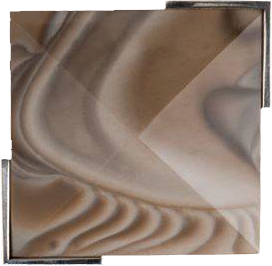 I have often been questioned why I have directed my attention to striped flint. What was the reason that I have decided to recommend it as the main item of the Polish jewelry, in particular, silver jewelry ?
I have often been questioned why I have directed my attention to striped flint. What was the reason that I have decided to recommend it as the main item of the Polish jewelry, in particular, silver jewelry ?
In 1971 I changed my place of living and moved from Słupsk to Sandomierz. I was enchanted with its historical, archeological and landscape attractions. The best way to acquaint oneself with one’s town is to study its history. While visiting the Sandomierz Museum I noticed some Neolithic axes made from very attractive stone - striped flint. I wondered why I had not seen such axes in the Słupsk Museum. Tools exhibited there were made from either brown or yellow flint. My answer was simple , ’such beautiful stone can only be found in the Sandomierz Region’.
My creative gifts have been employed to design and create artistic jewelry. I have asked myself the question: ‘Can flint come up to the standards required in jewelers’ work?
My answers were: Rarity - yes, decorative effect - obviously yes, hardness 6,5 -7 in the Mohs’ scale of hardness of 10. ( 10 represents the hardness of a diamond )
My first items of jewelry combined with flint were created in 1972. It turned out that there were other people apart from me that liked flint very much. I have frequently been taking part in artistic jewelry exhibitions with success. Striped flint has always been a constant element of my jewelry items. I have spent many hours talking with geologists, among others with an outstanding academic, Zdzisław Migaszewski, who knows not only the Świętokrzyskie Mountains as a geologist but as a hiker as well. These conversations have deepened my conviction that striped flint is scarce and it is worth using it in creating jewelry. Besides, items of jewelry are not only decorative objects but means of conveying emotions and relationships between man and stone, man and man, and man and group. I had a chance to acquaint myself with flint closer and to learn about its origin, its function and its significance in the lives of primitive men when I visited the Neolithic flint mine – Krzemionki Opatowskie. Jerzy Tomasz Bąbel’s speculations, his lectures and his informal conversations on mining, exploitation and use of striped flint thousands of years ago have allowed me to notice a magical factor attached to flint. Flint was used to produce axes which were not in daily use. These objects were of special nature and related to rituals, magic and spirituality. Modern researchers come across such tools in the areas far from the Świętokrzyskie Region in which the common types of flint are usually found.
All these factors have contributed to my conviction that I have followed the right way and my work on striped flint is meaningful. I have looked for the sites where striped flint can be found. I have already visited Krzemionki Opatowskie. I have discovered Iłża but I have come across the most beautiful samples in the village Śródborze near Ożarów. In the limestone of the quarry there were some beautiful concretions. Inhabitants of the region have been digging out building stone in here but flint embedded in it has been considered as a kind of a useless weed. Flint concretions worthy of the sculptor’s attention were lying there awaiting transportation. Some of them reminded me of Moore’s and Arp’s works of art. Their fate was to harden a field road. Did flint deserve such fate? Should we not enjoy its beauty?
Striped flint has been admired for its uniqueness at numerous jewelry exhibitions. It has been an object of interest not only for ladies but also press and TV. Information on flint has appeared in the newspapers and on TV screens. Collectors of minerals have shown so much interest in it that they have demolished the field road…
Finally striped flint has been noticed by the director of the Gold Work Art Museum in Kazimierz nad Wisłą, Jerzy Żurawski. He has offered to organize the all year round exhibition of my works.
The exhibition has been shown in Munchen and Wien. Striped flint has been admired everywhere.
Austrian and German jewelers have begun to use it in their work. The quarry has also changed its function. Nowadays limestone is a waste material and the quarry is used mainly for obtaining striped flint.
A couple of years ago I put forward a suggestion to Zofia Czub, the Head of the District Museum in Sandomierz. The proposal concerned my willingness to cooperate with her in organizing gold-work art workshops. The object of the workshops was to be the jewelry combined with striped flint executed by the best Polish artists. Seeds were sown in the fertile soil. We have already had several editions of workshops. The District Museum has got an imposing collection of striped flint jewelry. It is the first collection of this kind in the world. This whole venture would not have been possible without creative and organizational skills of the Museum employers, in particular The Head Zofia Czub and the Curator Bożena Wódz..
The amount of striped flint obtained from quarries and the size of its import have surpassed my expectations. At the moment my main activity is to provide some legal protection to striped flint. It is a Polish treasure and it should be used in the Polish jewelry.
This is how striped flint has returned to us after four thousand years of neglect.
The people wearing the stone for years have called it ‘The Stone of Optimism” - Might there be something in it?
Cezary Łutowicz


